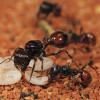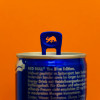Disgust starts in the stomach
Interview with
Disgust is a rather powerful response, and not one we tend to habituate to, according to Cambridge University's Duncan Astle who this month looked at a study which found that interfering with stomach activity can influence our emotional disgust response. And this could be big news for people who suffer from pathological, extreme disgust...
Duncan - They recruited subjects and they tracked their eye movements whilst they watched images of faeces, paired with neutral stimuli like pictures of buttons or something. And what you find very reliably is that when you pair these images together, people will always choose to look away from the disgusting image and towards the neutral thing. And if you reward them for looking at the disgusting image, so you kind of pay them to look at the poo, then you find that they will do it for a reward. So they will do it for money. But as soon as you take the reward away, they very quickly return to their previous behaviour, which is to look away from the disgusting image. That's a really reliable finding.
Katie - Makes sense!
Duncan - And so what they then did was to give participants either a placebo pill or a domperidone pill. So domperidone is an anti-emetic, it's an anti-sickness drug. And when subjects were on the domperidone, this paying people to look at the poo carried over significantly more into the subsequent phase, implying that the training that you get when you're being rewarded for looking at the disgusting image, had a more long lasting effect on behaviour. By altering people's gut reaction in their stomach, to the disgusting image, you had also influenced their behavioural response to it.
Katie - So what mechanistically is domperidone changing in the stomach then?
Duncan - Well, it acts via dopamine and it's thought to influence the rhythmic muscular movements that your stomach does. And so when you see something disgusting, you get to kind of dysrhythmia, I kind of disruption of the stomach's natural rhythm, that feeling down in your gut that's not very pleasant. The medication is designed to interfere with that process. And so the idea is - which is really quite a controversial idea - is that your behavioural response to disgusting material isn't just sort of driving the physical gut response to it on its own. You can actually get the reverse. So that if you alter the physical response to the material in your stomach, then that can influence the behaviour. So the causality can run in the opposite direction to the direction you might think of it.
Katie - So what you're saying is, the turning of your stomach that you might experience when you see something disgusting and awful could actually be causing you to feel disgusted.
Duncan - Exactly.
Katie - Does this suggest that a drug that acts in this way, like domperidone, could be a way of treating people who have a really adverse, sort of over-the-top disgust response?
Duncan - So in this case, what they were able to show is that when you pair the drug with in this case, the adverse training - so paying people to look at the poo - that's when you get the effect. And so I guess, if we were to extrapolate that out to a clinical setting, it might be that what you do as a therapy is combine behavioural therapy with something - this case, you know, the anti-emetic drugs - there might be some sort of physical symptoms to treat as well as the behavioural symptoms. And that doing both things together might have some effect on these very hard-to-shift biases that people might have.
From disgust to cravings now, and social cravings to be precise. ARU perceptual psychologist Helen Keyes told Katie Haylor about a study that asked whether social isolation could provoke a response similar to being hungry - in other words, can you crave company in a similar way to craving food? And what does this social craving look like in the brain? Here’s Helen.
Helen - So to look at this, they recruited 40 participants and they recorded their brain activity in an MRI machine in three different conditions. After 10 hours of fasting, after 10 hours of social isolation - so no social stimulation, no social media, not even allowed to read a novel, just completely isolated - or in the control condition. So when the participants hadn't been deprived of food or social contact.
Now the behavioural results was measured using questionnaires on self-reported cravings. And probably not surprisingly, participants reported craving food after the fasting condition. And they reported craving social contact after the social isolation condition. But much more interesting was the findings around the neural responses. So the dopaminergic mid-brain regions were particularly of interest here. So these areas are activated traditionally by cravings for food and addictive drugs. So the researchers were particularly interested in what would happen here.
Now, when the participants were in the MRI machine, they did a task called a cue induced craving task. Essentially the participants were shown images of the things that they might be craving and their brain activity was monitored. And what I like about this experiment was they actually tailored it to each participant. So they asked participants what their favorite social activities were. They tailored those images to you specifically, and they did the same with your favourite foods, or you were just shown control images of flowers. And they found, interestingly, that responses to food cues in this dopaminergic midbrain region that is kind of associated with cravings and addiction, they found that responses to food cues were higher after the fasting condition, compared to the other conditions. And they found that responses to social cues were higher after the isolation condition, compared to fasting. And these responses, the strength of these neural responses was correlated with your self reported cravings. So the more you were craving food or social contact, the stronger the response in the brain.
They also showed a narrowing of focus. So when you had been fasting, not only was your hunger response strong, your response to social cues actually was lowered compared to baseline. So your brain was essentially really honing in on the object that you were craving, what you had been deprived of. And the same happened if you'd been in social isolation, your response to pictures of friends and social contact was heightened, but your response to food was actually lowered compared to baseline. So it kind of goes along with what we know about this narrowing of focus to focus on your goal of attaining that thing that you're desiring, that you're missing.
They did look at two other areas of the brain called the substantia nigra and the ventral tegmental areas. And these areas are really associated with food and drug cravings. Now they only showed the increased response to food after fasting. Those areas didn't show an increased response to images of social interaction after isolation. So those very specific areas didn't. The broader dopaminergic midbrain region did show that almost parallel response, that it shifted towards food when you'd been fasting and shifted towards images of social contact when you'd been in isolation.
Katie - So what does that mean then?
Helen - Well, it's really quite nice. We know that in mice, in the same areas of their brains, the dopaminergic midbrain, we know that when that area is activated, following social isolation, this leads them directly to seeking out social interaction. So it seems that it serves a purpose. And it would make sense that it goes hand-in-hand with this narrowing of focus. It seems that when this area is activated by a craving, whether it's for food or social interaction, you are motivated then to seek out that reward of finding that social interaction or food, which is lovely. And the narrowing of focus would suggest that it really, your brain is almost assisting you, "I really need this, go get this to the exclusion of everything else".
Pre-pandemic, this type of research would have been valuable for looking at things like prison inmates, or people with long-term health conditions that mean they're quite isolated from social contact. I think what will be quite interesting with this research is to look at factors that can alleviate this. So it would be really nice to see if, for example, a video call can satisfy our social cravings in the way that more direct social contact might satisfy that. So I think there's more research to be done here in response to the pandemic.










Comments
Add a comment